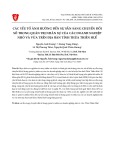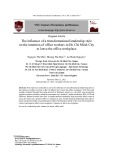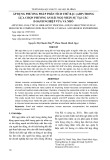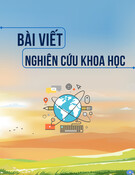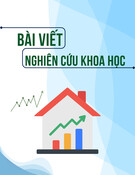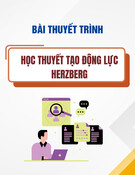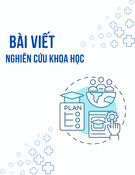JOURNAL OF SCIENCE AND TECHNOLOGY DONG NAI TECHNOLOGY UNIVERSITY
286
Special Issue
GREEN HUMAN RESOURCE MANAGEMENT IMPACTS JOB PERFORMANCE: THE MEDIATING ROLE OF PERCEIVED GREEN ORGANIZATIONAL SUPPORT
Luu Minh Vung*
Dong Nai Technology University *Corresponding author: Luu Minh Vung, luuminhvung@dntu.edu.vn
GENERAL INFORMATION
ABSTRACT
Received date: 11/03/2024
Revised date: 21/05/2024
Accepted date: 16/07/2024
the
relationships between GHRM and
KEYWORD
Green human resource management;
the
Job performance;
Perceived green organizational support..
This study investigates the impact of Green Human Resource Management (GHRM) on Job Performance (JP), with a focus on the mediating roles of perceived green organizational support. Drawing on data collected from employees in Vietnamese enterprises, the research utilizes PLS-SEM to job examine performance outcomes. The findings reveal that GHRM positively influences job performance, and this effect is significantly mediated by perceived green organizational importance of support. These results underscore integrating green practices into human resource management to enhance job performance. The study contributes to the growing body of literature on sustainable management practices by highlighting the critical roles of green support perceptions in the GHRM - JP relationship.
1. INTRODUCTION
The
to
training, green
costs,
in theory of green human resource management (GHRM) is developed based on the main green activities belonging functions of human resource management in implementing the context of successfully protection environmental sustainable strategies. GHRM has elements such as green recruitment, green participation, green rewards, and green (Ahmad, 2015; performance management Chaudhary, 2019; Shah, 2019). Practicing GHRM can lead to higher job performance, environmental increased lower awareness, and better employee engagement (Dumont et al., 2017; Saeed et al., 2019; Renwick et al., 2013; Ragas et al., 2017). According to the National Strategy on Green Growth and Sustainable Development in Vietnam, a green economy in Vietnam will need many green businesses to create many green jobs: The Vietnam National Strategy on Green Growth Phase 2021-2030, vision 2050 (Decision No. 1658/QD-TTg, October 1, 2021). From now on, Vietnam needs to have many green businesses and green human resource management to replace the current human resource management. However, there is very little research on green human resource management and job performance (JP) of employees the context of Vietnamese enterprises.
287
Special Issue
JOURNAL OF SCIENCE AND TECHNOLOGY DONG NAI TECHNOLOGY UNIVERSITY
(RBV), success (Lakhal et al., 2006), so companies always try to improve their employees' job performance.
if
Perceived green organizational support (PGOS) is an employee's specific belief regarding the extent to which the organization values their contribution to sustainability (Lam et al., 2015).
according to
Research by Ragas et al. (2017) shows that GHRM has a very strong impact on JP. Furthermore, research by Aboramadan & Karatepe (2021), GHRM has an impact on perceived green organizational support (PGOS) and at the same time, PGOS has an impact on JP.
According to Barney (1991), with the resource-based any view organizational resource is divided into three main types: human resources, organizational capital, and physical capital. The resources controlled by a company are the basis for sustainable competitive advantage the company is able to make these assets (1) valuable, (2) rare, (3) difficult to imitate, and (4) irreplaceable. The truth is that no company can survive and develop without employees. The current international competitive and business landscape is a flat world, forcing CEOs and HR managers in companies to change from thinking to action - moving from the perspective of "employees are costs" to the perspective of "employees are the most important asset."
In the context of Vietnamese enterprises aiming for a green economy and sustainable theories (GHRM, development, based on RBV, EE), and previous studies. Hypotheses and a research model have been proposed by the author (Figure 1.1): around long-term
Green human
A new theoretical framework for human resource management introduced (HRM) by Cardy et al. (2007) is employee equity (EE). It relationships revolves between employees and companies (employee lifetime value, ELV), rooted in the actions of the company and employees to establish, build, and maintain the relationship. Based on ELV, the company will determine the level of job satisfaction, organizational commitment, employee retention, and job performance of employees or groups of employees.
engagement and of (PGOS) In this study, the author seeks a model and explanation for the impact of GHRM on JP through the intermediary role of perceived green organizational support in Vietnamese enterprises.
criterion for Job performance (JP) is the behavior that employees demonstrate at work to bring about the results the organization desires in terms of work quality, work quantity, and working time (Na-Nan et al., 2018). Job performance is an businesses, important results and demonstrating the company's resource management (GHRM) practices have been increasingly recognized for their potential to positively impact job performance (JP). According to the resource-based view (RBV) theory, human resources are considered a strategic asset that can provide organizations with a competitive advantage (Barney, 1991). When organizations implement GHRM practices, they not only align their HR strategies with environmental sustainability but also enhance the skills, motivation, their employees. This alignment contributes to a more committed and productive workforce, which in turn leads to higher job performance (Renwick et al., 2013). GHRM practices, such as providing training on environmental issues and encouraging green initiatives, can increase employee engagement by making them feel that their work is meaningful and aligned with broader societal goals (Dumont et al., 2017).
JOURNAL OF SCIENCE AND TECHNOLOGY DONG NAI TECHNOLOGY UNIVERSITY
288
Special Issue
their best,
is committed the organization
this theoretical
environmental awareness in organizations with
As a result, employees are more motivated to perform at thereby enhancing overall job performance. Empirical studies support this theoretical link between GHRM and job performance. For instance, Saeed et al. (2019) found that organizations practicing GHRM observed significant improvements in employee performance metrics, partly due to increased and employee involvement in green initiatives. These findings suggest that GHRM not only fosters a culture of sustainability but also drives superior job performance, supporting the hypothesis that GHRM has a positive impact on JP. organization’s commitment H1: GHRM has a positive impact on JP sustainability, Green human
green organizational
of organizational support (Dumont et al., 2017). This perceived alignment fosters a sense of belonging and reinforces the belief that to environmental stewardship, leading to higher levels of PGOS. Empirical studies further substantiate linkage. For instance, Norton et al (2015) found that employees robust GHRM practices reported higher levels of PGOS, which was associated with increased employee motivation to participate in green behaviors. Similarly, a study by Pham et al (2019) demonstrated that GHRM practices positively influence employees' perceptions of to their environmental thereby reinforcing PGOS. These findings support the hypothesis that GHRM has a positive impact on PGOS, as organizations that prioritize green practices are perceived as more supportive by their employees. and values H2: GHRM has a positive impact on PGOS view (RBV)
including
organizations
behavior—they signal
environmental
resource management (GHRM) practices can significantly enhance support perceived (PGOS), a concept that reflects employees' perceptions of the extent to which their supports organization environmental sustainability. According to the resource-based theory, sustainable competitive advantage can be achieved by leveraging unique organizational resources, environmentally- conscious human resources (Barney, 1991). implement GHRM When practices—such as eco-friendly recruitment, green training programs, and rewards for their sustainable commitment to environmental values, which in turn strengthens employees' perceptions of green organizational support (Renwick et al., 2013). When employees perceive strong organizational support for their personal and professional values, they are more likely to feel engaged and aligned with organizational goals (Kahn, 1990). GHRM practices that emphasize sustainability resonate with employees who value green initiatives, thereby enhancing their perception Perceived green organizational support (PGOS) is a critical factor influencing job performance (JP), as it reflects the extent to which employees believe their organization their environmental values and supports efforts. According to the resource-based view (RBV) theory, organizations can gain a competitive advantage by cultivating valuable, rare, and inimitable resources, including a committed and environmentally conscious workforce (Barney, 1991). When employees perceive strong support for green initiatives from their organization, they are more likely to feel valued and motivated, which in turn enhances their job performance (Renwick et al., 2013). Employees who perceive high levels of organizational support are more likely to be engaged and perform well (Kahn, 1990). PGOS fosters a sense of alignment
289
Special Issue
JOURNAL OF SCIENCE AND TECHNOLOGY DONG NAI TECHNOLOGY UNIVERSITY
and values employees' Vietnamese enterprise's context aims for a green economy and sustainable development.
Using the scale with adjusted research variables by Kim et al. (2019) on GHRM has 5 items, Aboramadan & Karatepe (2021) on PGOS has 6 items and Chen et al. (2010) on JP has 5 items.
overall organization’s reversible corroborates evidence link between PGOS and
into
to verify
thereby supporting
between the organization’s environmental goals, leading to job satisfaction and motivation increased (Dumont et al., 2017). This engagement translates into higher job performance, as employees who feel supported in their green initiatives are more likely to go above and beyond in their roles, contributing positively to performance. the this Empirical theoretical job performance. For instance, Kim et al. (2017) found that employees who perceive their organization as supportive of green practices report higher job satisfaction and performance levels. Similarly, a study by Pham et al. (2019) demonstrated that PGOS not only enhances to environmental employees' commitment goals but also job improved to leads performance by fostering a supportive work environment. These findings suggest that organizations that actively promote and sustainability can support environmental expect a positive impact on their employee's job performance, the hypothesis that PGOS has a positive impact on JP.
H3: PGOS has a positive impact on JP
Figure 1.1. Research model
2. METHODOLOGY
on
This study explores the impact of green human job resource management performance, focusing on the mediating role of perceived green organizational support in the The scale uses the English language, so a English-Vietnamese two-way translation technique will be implemented. Initial translation: The original scale should be translated by a bilingual expert fluent in both the source (English) and target languages (Vietnamese). Back translation: The translated the scale should be back-translated original language by a different bilingual expert who has not seen the original scale. This helps the accuracy and equivalence of the translation. Comparison and reconciliation: The original and back- translated versions of the scale should be compared to identify any discrepancies. Pre- testing: The translated scale should be pre- tested on a small sample from the target (employee). This helps to identify any items that may be confusing or misinterpreted in the new context. Refinement: Based on the feedback from the pre-test, the scale may need to be refined. This could involve rewording certain items or adjusting the translation to better fit the cultural context. Final validation: Once the scale has been refined, it should undergo a final round of validation with a larger sample (employees). This ensures that the scale is reliable and valid for the survey. The questionnaire was set up with 4 parts: questions Screening about questions, Vietnamese enterprises information, main survey questions, and personal information about respondents. The pilot survey will be deployed with a sample of about 30 candidates who are employees working in Vietnamese enterprises in Ho Chi Minh City. A pilot
JOURNAL OF SCIENCE AND TECHNOLOGY DONG NAI TECHNOLOGY UNIVERSITY
290
Special Issue
enterprises private have
74.6%, intermediate graduates and others, there are 39 employees, accounting for 18.7%; Regarding types of enterprises, state-owned enterprises have 29 enterprises accounting for 13.9%, 140 enterprises accounting for 67% and other types of enterprises have 40 enterprises accounting for 19.1%.
3.2. Validation of scales
survey to collect opinions, edit questionnaire wording, and check the reliability of the scale. Then the official survey will be conducted in Ho Chi Minh City, from October to December 2023, with an expected sample of 300. Ho Chi Minh City was chosen to collect data because Ho Chi Minh City has the highest number of operating businesses in 2022 nationwide with 274,067 enterprises, accounting for 30.6% of the country's operating enterprises in 2022 (Vietnam Enterprises White Paper, 2023). The number of survey questionnaires distributed was 250 copies, 220 copies were collected, and after screening and checking for errors, the remaining sample was 209 copies. Table 3.1, shows that the Alpha coefficient is about 0.834 to 0.887; Composite reliability (CR) > 0.7; Average variance extracted (AVE) > 0.5. Thus, the scale of research concepts achieves reliability and convergence (Hair et al., 2019).
Table 3.1. Scale
to estimate
Scale
CR
AVE
Cronbach’s Alpha
This study uses a quantitative research method, by PLS-SEM the measurement model (SRMR, VIF, R2, Q2), test the structural model, and research hypotheses (Hair et al., 2019) in SmartPLS 4.0.
GHRM
0.887
0.917
0.689
3. FINDINGS AND DISCUSSION
PGOS
0.834
0.889
0.668
3.1. Descriptive statistics
JP
0.838
0.892
0.674
Source: Analysis results
the
in The pairs of correlated research variables (Table 3.2) all meet standard of Heterotrait-Monotrait ratio (HTMT) < 0.90 (Hair et al., 2019). Therefore, the research concepts the model have achieved discriminant value.
Table 3.2. Heterotrait-Monotrait (HTMT)
GHRM
JP
PGOS
GHRM
1
JP
0.899
1
PGOS
0.741
0.832
1
educational
Source: Analysis results
3.3. Test the model and research hypotheses Survey results show that in terms of gender, males have 105 employees, accounting for 50.2%, females have 104 employees, accounting for 49.8%; In terms of age, under 24 years old there are 16 employees accounting for 7.7%, from 25 to 29 years old there are 94 employees accounting for 45%, from 30 to 39 years old there are 81 employees accounting for 38.8%, from 40 to 49 years old there are 17 employees accounting for 8.1%; Regarding working seniority under 1 year, there are 20 employees accounting for 9.6%, there are 90 employees from 1-3 years accounting for 43.1%, from 3-5 years there are 51 employees accounting for 24.4%, over 5 in the year, there were 48 employees, accounting for 23%; Regarding level, university graduates have 14 employees, accounting for 6.7%, university graduates (college) have 156 employees, accounting for
291
Special Issue
JOURNAL OF SCIENCE AND TECHNOLOGY DONG NAI TECHNOLOGY UNIVERSITY
In PLS-SEM, the suitability of the model will be evaluated based on standards such as SRMR, VIF, R2 and Q2. GHRM has a weaker impact on JP (β = 0.565) than on PGOS (β = 0.643), and PGOS has a weaker impact on JPR (β = 0.337).
Testing the research model resulted in
Table 3.6. Indirect effects
SRMR = 0.07 < 0.08.
Impact p value Conclude
GHRM -> PGOS -> JP
0.217
0.000
Accept
Source: Analysis results The results in Table 3.3 show that there is no multicollinearity phenomenon because all pairs of variables have VIF < 3 (Hair et al., 2019).
Table 3.3. VIF
GHRM
JP
PGOS
GHRM has an indirect impact on JP through the intermediate variable PGOS (β = 0.217).
1.706
1.000
GHRM
Results of model testing and research
JP
hypotheses.
1.706
PGOS
Source: Analysis results
R2 values range from 0.414 to 0.678 and Q2 ranges from 0.272 to 0.439 (Hair et al., 2019) in Table 3.4:
Table 3.4. R2 and Q2
R2
Q2
***: Statistically significant, p-values =
JP
0.678
0.439
0.000
PGOS
0.414
0.272
Figure 3.1. Results of Model
Source: Analysis results
3.4. Discussions technique Implement
in the Bootstrap SmartPLS 4.0 software to test, in Table 3.5, accept to H3) the hypotheses (from H1 because the p-value = 0.000 < 0.05 with 95% confidence at the significance level 5%.
Table 3.5. Results of hypotheses and impacts
Impact p value Conclude
According to Ringim et al. (2012), if the impact is not higher than 0.75, it is good. In this research case, all pairs of variables in the model have impact coefficients < 0.75 and have positive values, the research hypotheses (from H1 to H3) are accepted. The impact of GHRM on PGOS is stronger than the impact of JGHRM on JP, the impact of PGOS on JP is weaker.
GHRM -> JP
0.565
0.000
Accept
GHRM -> PGOS
0.643
0.000
Accept
PGOS -> JP
0.337
0.000
Accept
Furthermore, the indirect effect through the intermediate variable GHRM -> PGOS ->JP is 0.217 with p-values equal to 0.000 < 0.005. Thus, GHRM not only has a direct impact on
Source: Analysis results
JOURNAL OF SCIENCE AND TECHNOLOGY DONG NAI TECHNOLOGY UNIVERSITY
292
Special Issue
JP but also through the intermediate variable PGOS has an indirect impact on JP.
foster can a
improved crucial for is First, managers should integrate green practices into their HRM strategies to not only promote environmental sustainability but also to boost employee performance. By doing so, organizations stronger organizational commitment among employees, which job performance.
the Second, highlights
should Comparing the results of this study with previous research, it shows that the impact of GHRM on JP with 0.565 is weaker than Ragas et al. (2017) with 0.72; The impact of GHRM on PGOS equal to 0.643 is stronger than Aboramadan & Karatepe (2021) equal to 0.53 and the impact of PGOS on JP equal to 0.337 is weaker than they are equal to 0.63. Maybe it's because the Vietnamese business context is different from other countries.
thereby strengthening the study importance of perceived green organizational support. Managers actively communicate the organization’s commitment to environmental initiatives and provide the necessary resources and support to employees engaged in green practices. This will enhance employees' perception of the organization’s green values, their commitment and performance.
green human
Moreover, managers should focus on creating a culture that values sustainability. This includes providing training programs that emphasize the importance of green practices and their impact on both the environment and the organization’s success. By embedding sustainability into the organizational culture, managers can enhance employees’ alignment with the organization’s green goals, leading to higher job performance.
to ensure
Research results show that GHRM has a direct and indirect impact on JP in the Vietnamese enterprises context. PGOS had an intermediary role in the relationship between GHRM and JP. Thus, increasing employee job performance not only comes from enterprises resource implementing management but also from the green support of the organization. The theory of EE (Cardy et al., 2007) emphasizes if enterprises view employees as assets with a view of long-term value, employees will stay in the enterprises and make more contributions, meaning the employee's job performance will increase over time long-term working time at enterprises. From the perspective theory of RBV (Barney, 1991), it shows that enterprises will gain sustainable competitive advantages from green human resources and employees will increase job performance when enterprises view them as resources (assets).
4. MANAGERIAL IMPLICATIONS
support, which are essential long-term job Finally, the study suggests that managers should regularly assess and refine their GHRM practices they are effectively to both environmental and contributing organizational goals. Continuous improvement in GHRM can help maintain high levels of organizational commitment and perceived green for sustaining performance improvements. employee to
REFERENCES
Based on the results of this research, managers at enterprises have more grounds to invest in and develop green human resource job increase management performance, thereby increasing profits and sustainable development of Vietnamese enterprises next time.
Aboramadan, M., & Karatepe, O. M. (2021). resource management,
Green human
293
Special Issue
JOURNAL OF SCIENCE AND TECHNOLOGY DONG NAI TECHNOLOGY UNIVERSITY
perceived green organizational support and their effects on hotel employees’ behavioral outcomes. International Journal of Contemporary Hospitality Management, 33(10), 3199-3222.
Kim, Y. J., Kim, W. G., Choi, H. M., & Phetvaroon, K. (2019). The effect of green human resource management on hotel employees’ eco-friendly behavior and environmental performance. International journal of hospitality management, 76, 83- 93.
Barney, J. (1991). Firm resources and sustained of
advantage. Journal
competitive Management, 17(1), 99-120.
17(2),
Kim, S. L., Kim, M., Han, S., Jackson, S. E., & Ployhart, R. E. (2017). Multilevel influences of team diversity on team climate and effectiveness: Mediating role of leadership. Journal of Management, 43(6), 2089-2116.
in
Cardy, R. L., Miller, J. S., & Ellis, A. D. (2007). Employee equity: Toward a person-based to HRM. Human Resource approach Management 140- Review, 151.Chaudhary, R. (2019). Green human Indian resource management automobile industry. Journal of Global Responsibility, 10(2), 161-175.
Lakhal, L., Pasin, F., & Limam, M. (2006). Quality management practices and their performance. International impact on Journal of Quality & Reliability Management, 23(6), 625-646.
Chen, Y., Tjosvold, D., & Pan, Y. (2010). Collectivist team values for Korean– Chinese co-worker relationshiPC and job performance. International Journal of Intercultural Relations, 34(5), 475-481.
Lamm, E., Tosti-Kharas, J., & King, C. E. (2015). employee Empowering sustainability: Perceived organizational support toward the environment. Journal of Business Ethics, 128, 207-220.
Factor
values.
Dumont, J., Shen, J., & Deng, X. (2017). Effects of green HRM practices on employee workplace green behavior: The role of psychological green climate and employee green Resource Human Management, 56(4), 613-627.
Na-Nan, K., Chaiprasit, K., & Pukkeeree, P. analysis-validated (2018). comprehensive employee job performance scale. International Journal of Quality & Reliability Management, 35(10), 2436- 2449.
Hair, J. F., Risher, J. J., Sarstedt, M., & Ringle, C. M. (2019). When to use and how to report the results of PLS-SEM. European Business Review, 31(1), 2-24.
Norton, T. A., Zacher, H., & Ashkanasy, N. M. (2015). Organisational sustainability policies and employee green behaviour: The mediating role of work climate perceptions. Journal of Environmental Psychology, 38, 49-54.
Kahn, W. A. (1990). Psychological conditions of personal engagement and disengagement at work. Academy of Management Journal, 33(4), 692-724.
JOURNAL OF SCIENCE AND TECHNOLOGY DONG NAI TECHNOLOGY UNIVERSITY
294

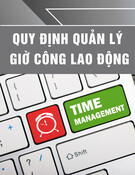
![Quy định chế độ bàn giao của cán bộ nhân viên [chuẩn nhất]](https://cdn.tailieu.vn/images/document/thumbnail/2025/20250605/namthangtinhlang_00/135x160/282_quy-dinh-che-do-ban-giao-cua-can-bo-nhan-vien.jpg)

![Quy định hội nhập môi trường làm việc [chuẩn nhất]](https://cdn.tailieu.vn/images/document/thumbnail/2025/20250605/namthangtinhlang_00/135x160/83481749185490.jpg)
